Clyde Caldwell: The Cool Fantasy Artist Who Made D&D Hot
Today, we are speaking with the amazing fantasy artist, Clyde Caldwell. Clyde has been enchanting RPG, book, and art fans for decades with his badass dragons, beautiful maidens and scenes of epic adventure.
JQ: First off, let me congratulate you on your most recent interview with Illustration Magazine. I received my copy and was astounded at the quality of both the illustrations and the interview itself. 48 pages! Well-deserved. How does it feel to be recognized and so highly esteemed even after so many years in the business?
CC: I felt really honored to be featured in Illustration Magazine. To my knowledge the magazine has featured only a couple of other fantasy artists over the years, so I was delighted to be included.
JQ: That makes it even more special for sure. I was happy to learn so much about you from that article, so will only ask questions I haven’t seen in that article or other interviews you have done, but most of all let’s have fun.
BTW: I highly recommend Clyde fans purchase a copy of #79 Illustration magazine while you can! https://the-illustrated-press.myshopify.com/products/illustration-79
JQ: Clyde, I’ve read that Frank Frazetta was a huge influence on you back in the day. Did you ever get a chance to meet or correspond with him?
CC: I never got a chance to meet Frank Frazetta, nor did I ever correspond with him. I'm pretty shy, so can't imagine striking up a conversation with Frank, should I have met him. I would have been totally intimidated, so would have gone into fanboy mode, I'm sure.
I had never seen a Frazetta original painting until a few years ago. There was a travelling exhibit of his work at a convention in Chicago and Jeff Easley, my wife, Sharon, and I went down to see it. It was mind blowing to see some of his originals in person.
A few years later, Sharon and I went on a pilgrimage to the Frazetta Museum in East Stroudsburg, PA. That was an incredible experience as well. I'm trying to get Sharon to go down to Florida to see the Frazetta Gallery there. That's on my bucket list.
JQ: I was always impressed with Frazetta’s work too from magazine and book covers - can’t imagine how impressive his full-size originals must be in person.
Since we’re on the topic of other artists, during the fantasy heyday at TSR, you worked with other greats, such as: Jeff Easley, Larry Elmore, Brom, Keith Parkinson, Jeff Butler, Tim Truman, and I imagine many more. I was happy to read you guys all got along and helped each other out. Here’s a quote:
“When I got to WI and met with the other TSR artists, I felt that they were kindred spirits.” -Clyde Caldwell
JQ: Also, it sounds like Keith and Tim even played a practical joke on you by flipping all of your wall art upside down one night when you started! That sounds like a proper artist hazing to me. A conclave of “Bro-hemians”, one might say.
CC: I only got to work with Tim Truman for a couple of weeks. He was leaving TSR as I was coming in, though he seemed like a really nice guy. Keith and Tim were good friends. Tim played guitar and Keith played drums. After Keith left, I think he and his family moved to Pennsylvania, where Tim was living, and Keith and Tim started a little band. Had Tim stayed at TSR who knows, maybe I would have joined the band as well.
Not only did I get to work with a lot of other great artists, there were many other talented folk working at TSR as well. Game designers, authors, editors, graphic designers, mappers, sculptors...it was amazing how much talent was brought together under one roof.
I often thought it was a very unique situation...a once in a lifetime opportunity.
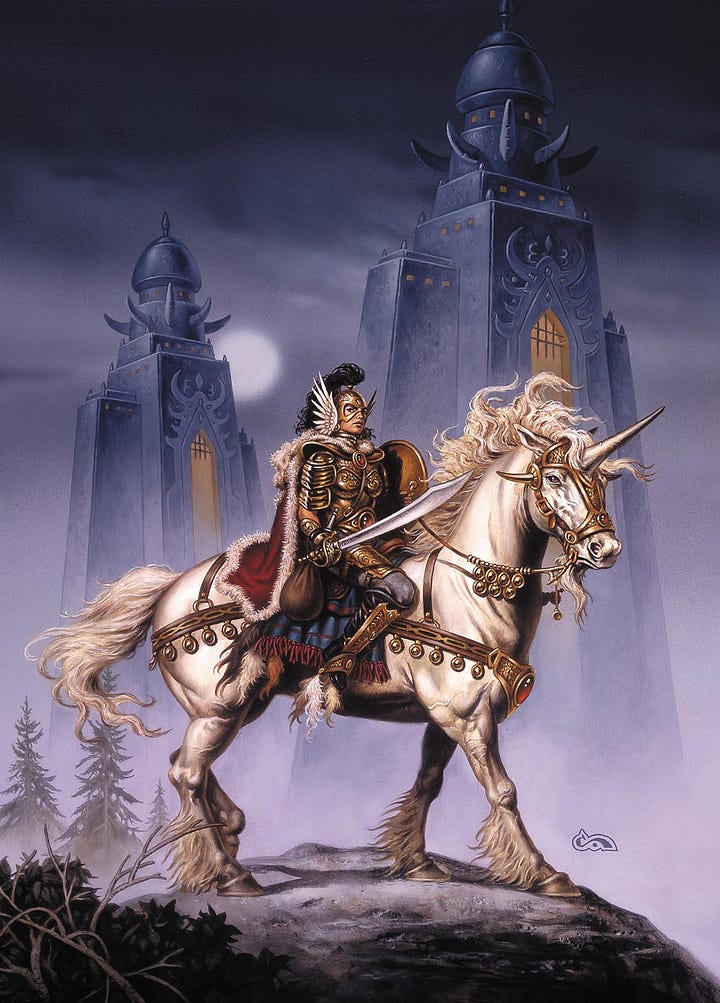
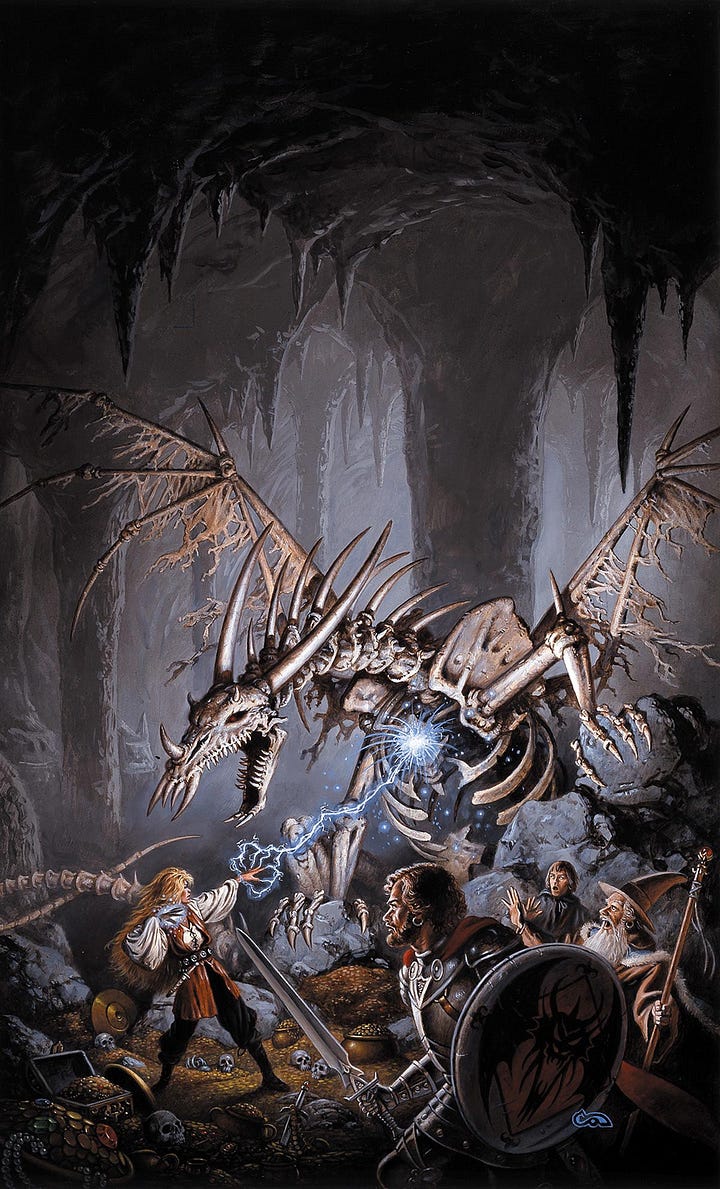
JQ: I’m very jealous. An interesting thing you said about your time at TSR, was that for a while, you guys felt a bit isolated from the consumers, not knowing how your work was being received (not having social media or the like back then). But once you started going to GenCons, you realized the effect your work had on so many. It had to be amazing to realize that you guys didn’t have consumers – you had raging fans! Tell us a little bit about those early GenCons.
CC: My first GenCon was kind of interesting. It was held on the UW Parkside campus. The "Art Show" was in a small room overlooking the gym. It was in the middle of summer and the room had no air conditioning, so it was hot. I had a couple of prints that I was used to selling at conventions before coming to TSR, so I commandeered a table and set up by the door coming into the room.
The other artists were aghast. They thought I was going to get into trouble, because none of them had sold prints at GenCon before. But I said, "That's what artists do at conventions."
As it turned out, no one said anything to me about selling the prints, and the practice slowly grew into a GenCon tradition for all the artists.

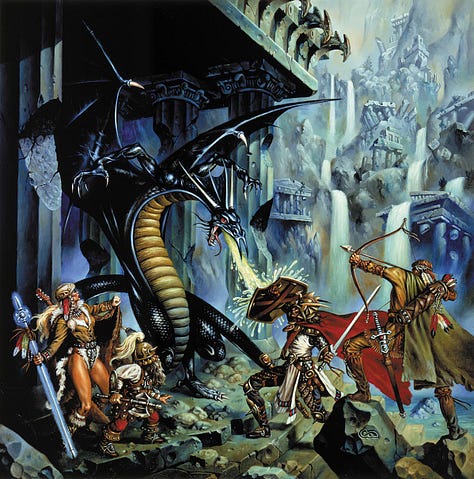
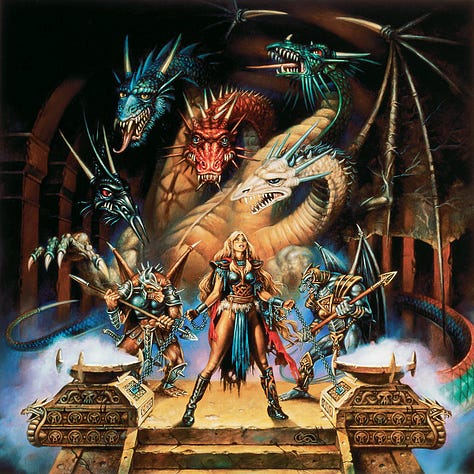
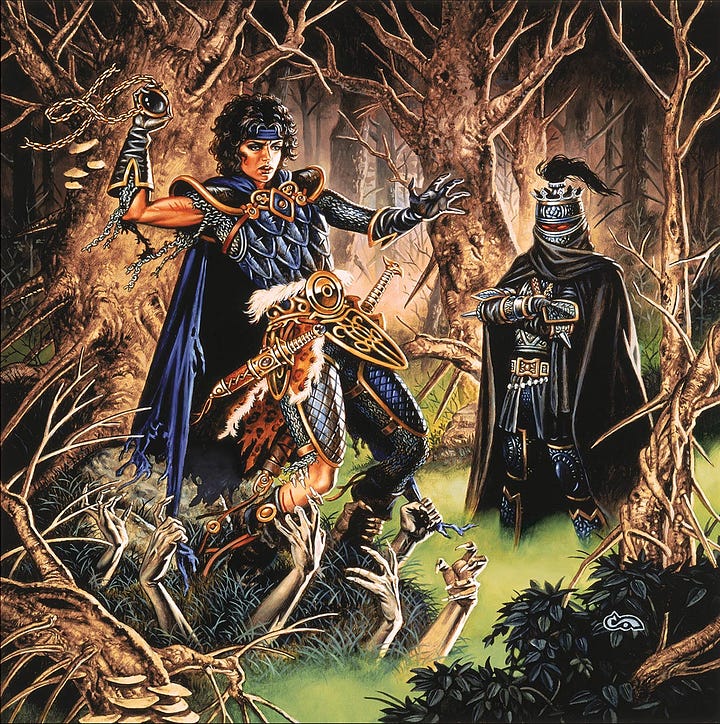
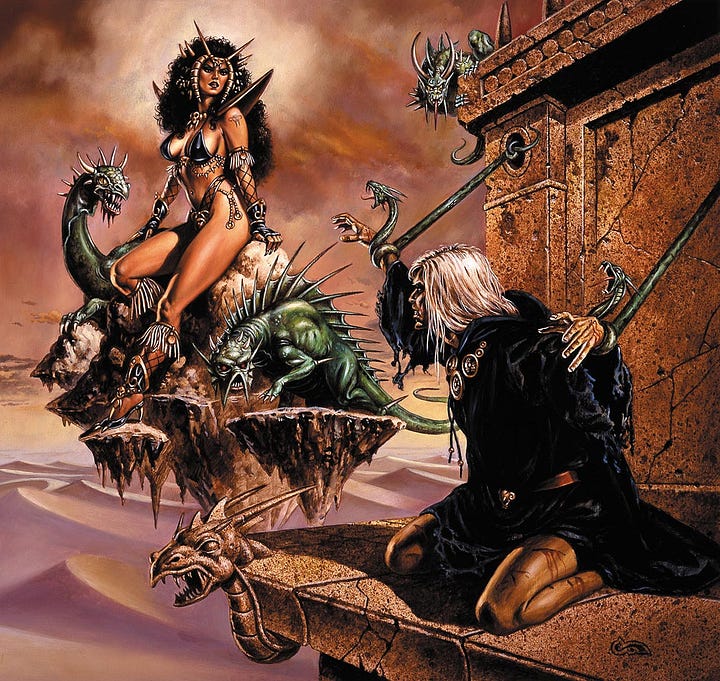
JQ: Ha! That’s a great story, and demonstrates you being unafraid of standing up to the status quo and being a trendsetter too. But let me ask you, fans throughout history can have a tendency to go a little overboard. What is the craziest thing you ever experienced at the Cons you’ve attended?
CC: In my experience, the gamers and fantasy art fans are some of the nicest, most well-mannered folks that you'd ever care to meet.
The costumes stand out in my mind. There were always a lot of amazing costumes. Sexy costumes, elaborate costumes, funny costumes...all very inspirational and fun, and all very creative.
A few fans would dress as characters from my paintings, which was cool. And some would have tattoos of characters from my paintings.
One of the weirdest things that I remember was a fellow who claimed to be a real vampire. He had his canines filed into sharp points, as did the lady who accompanied him. They were a little spooky.
JQ: I bet. I guess it would pay to wear a crucifix to those conferences from now on (or at least eat a lot of Italian food).
I’ve seen a few pictures of you and the boys back in the day struttin’ around town – were you all treated like rock stars wherever you went?
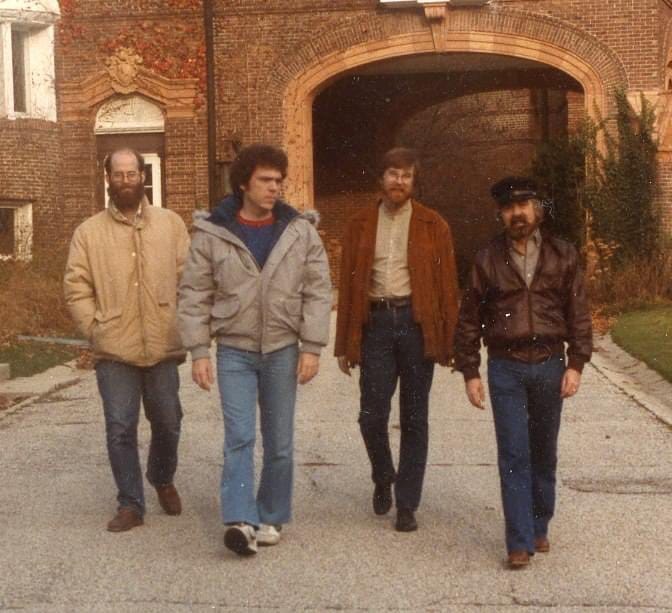
CC: Hardly! We enjoyed a bit of celebrity at GenCon and other conventions, but other than that, no one paid us much attention.
JQ: Well, I bet you were recognized in every part of Wisconsin at least. It seemed like that was THE mecca for all things fantasy back then. That’s even a big reason why you moved there from North Carolina. What was it like working around so many imaginative talented writers and artists back then?
CC: Honestly, I was rarely recognized outside of work. Maybe every now and again, but not often. TSR was really a hive of creativity. It was almost a palpable thing. The artists would bounce ideas off one another and ask each other for suggestions when we hit a snag in a painting.
When I first started work in the art department, I was new to oil painting. Jeff Easley and Larry Elmore had been painting in oils for years. I had previously been painting in acrylics and was finding the transition to oils somewhat difficult. So, I would pick their brains for oil painting advice.
JQ: Again, really jealous.
I recently did an article about the old TSR Conan Role Playing Game (1985), and included a discussion about its artwork, which included Jeff Easley’s, Jeff Butler’s and someone I didn’t recognize – Ruth Hoyer. It took some digging, but I found out she was TSR’s art director and she also did some illustration & graphic design.
CC: I remember the name, but can't really place her. I don't remember ever having a female art director at TSR. Maybe in the graphic design department, but not for the art department.
JQ: Fair enough. I share this, because, like raising a child takes a village, so does launching a successful product. There are often unsung heroes behind the scenes who are critical to making amazing stuff happen. Is there anyone in particular you can think of at TSR or other places you’ve worked that stand out in this regard?
CC: As illustrators, we're usually visualizing things written or made up, to one extent or another, by someone else. So, in that way, there is a collaboration of sorts going on in creating an illustration.
And of course, the cover and/or interior illustrations are only a part of the product as a whole. So, like baking a cake, there are many ingredients, but the cover illustration is like the icing. It's what you initially see when looking at a product for the first time.
And that includes the graphic design as well. But there were so many people working behind the scenes at TSR. Editors, proofreaders, typesetters, mappers, in addition to the writers and game designers, graphic designers and artists. Everyone had a part to play in producing a product, and even the people who were coordinating it all, art directors and people like that.
My boss told me once that I wasn't a team player, but we all really were part of one big team, working together toward the same end.
JQ: What’s your old boss’ name? It’s about time we straightened them out.
Before we move on to the next topic, I wouldn’t feel complete if I didn’t ask you about any potential rivalries with “the other guys” – you know, Boris Vallejo, The Hildebrandt Brothers, Joe Jusko, and other mainly-non-TSR artists. Did you all get along, or was it like the street brawl between news anchor crews from the Anchorman movie whenever you saw each other?
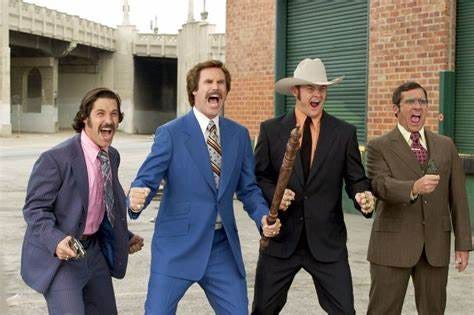
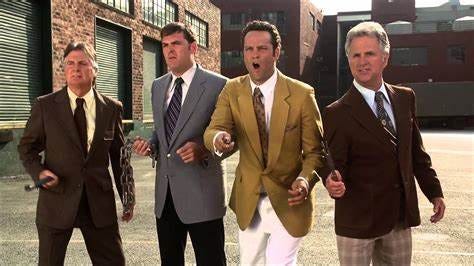
CC: I was always a big fan of many other fantasy artists. I met the Hildebrants at a convention or two, but they had no idea who I was. Then we had Tim come to a GenCon as artist guest of honor. He was super nice and I think we all enjoyed getting to know him a bit.
I also met Boris a couple of times. I'm a huge Boris fan, but I never really got to know him.
I also met Joe Jusko a couple of times, plus had a few email exchanges with him over the years. I've really become a huge Jusko fan. The work he's doing on the ERB Inc. reissues of the Tarzan titles is just phenomenal. He's such a good painter, and unlike me, he's fast. I can't say enough good things about his work.
And, no, I don't think any of the TSR guys had any rivalries with any other artists. Nothing that I recall.
JQ: Or . . . nothing you can talk about. What happens in Fight Club stays in Fight Club, amirite?
JQ: I’ve unintentionally only been talking about the guys, but there were so many amazing female fantasy artists during that time too - Rowena Morrill, Julie Bell, Valerie Valusek, just to name a few that come to mind. Did you ever get to collaborate or hang out with them?
CC: We got Rowena to come to GenCon one year as the artist GOH. I really enjoyed talking to her and I had always admired her work, especially her painting technique.
I only met Julie Bell very briefly a couple of times. At GenCon one year, I got on a elevator with Boris & Julie, but didn't realize it until they got off. I had yet to meet them, so was bummed that I had missed an opportunity to say hello.
I knew Valerie Valusek fairly well. She did a lot of freelance work for TSR and would often pop into the art dept. She was an equestrian and I once asked her to bring her horse by TSR so that I could take some reference photos. She was kind enough to oblige.
JQ: Very cool! Oh, one last question about TSR – Did they provide you all a pension, and was it paid out in electrum pieces?
CC: No electrum pieces. When I took the job at TSR, the company had a profit-sharing plan. After I'd worked there a little while, I had a bit of money built up in that.
However, the company ran into bad financial times and there were no profits to share. So, after awhile, they discontinued the profit-sharing plan, so that we could invest in our own IRAs. After I left the company, I understand they started up a 401k for the employees, but I wasn't there for that.
JQ: Let’s talk a little bit about your artwork. My exposure to you began at a young age, and so there are certain pieces that are etched into my soul – when I see them, they immediately bring me back in time and generate an electricity of excitement & adventure.
I’m going to mention my top 4 (oh boy, there are soooo many more I’ve come to love since then, but I have to reign it in) and was wondering:
What your thoughts on that particular work are, and
What’s one piece of cool trivia that hardly anyone knows about it?
Ready, here we go:
JQ: Streams of Silver – This was the cover of the book of the same name that featured the dwarf, Bruenor Battlehammer in battle-mode as well as Drizzt, Wulfgar and Regis looking on from the background. The Crystal Shard series will always be dear to me.
CC: 'Streams of Silver' is a popular painting with a lot of fans. I liked my interpretation of Bruenor, and was especially fond of the painting because of the tree with all the skulls.
How it all came about is as follows. An editor came into the art dept. and gave me an "art suggestion" for the cover of the book. It read something like this, "A group of adventurers are walking along a stream of silver."
I thought this was kind of a lame suggestion, so I called Bob Salvatore and told him what I had been given. He hit the roof, saying that the suggestion had nothing to do with the book. He then proceeded to explain what the book was about and what he saw as a good cover scene. I did the painting based on his notes, and he liked the painting enough to purchase the original.
JQ: That WAS a lame suggestion - I’m glad you went to the source and created this amazing piece.
JQ: White Magic Cover of Dragon Magazine #147. This is one of the few Dragon magazines I was able to obtain on my own as a kid. I remember falling in love with the enchantress on the front cover. I still have it, and she still has a part of my heart.
CC: I don't remember too much about this one. I like the little critter watching her cast the spell. I thought that was a fun touch.
Gail Reidy was the model for 'White Magic'. One year several of the TSR artists got a booth at the Bristol Renaissance Faire. Gail came by our booth, and I was immediately struck by how attractive she was. I asked her if she had ever done any modelling, to which the answer was yes.
Turns out she was a Miss America first runner up, a Jensen swimsuit model, and a former Miami Dolphins cheerleader, among other accomplishments. I was lucky enough to get her to model for several paintings, of which 'White Magic' was one.
See my article: A Dragon is at Your Door for some fun reminiscing about Dragon Magazine
JQ: Azure Bonds. From the book to the computer game (“Curse of the Azure Bonds”) to the Forgotten Realms D&D module, this was a piece of artwork that made its rounds and its fantastic effect felt.
CC: 'Azure Bonds' is another fan favorite and one of my personal favorites. The first use of this one was in a TSR calendar.
When I originally painted it, I had some red mixed in with the tattoo design. After the calendar was published, Jeff Grubb came to me and mentioned that the tattoo was supposed to be all blue, and asked if I would change it for the book cover. He also asked me to make Alias's hair a little redder, which I did. So, the painting in the calendar is slightly different from its subsequent publication on the book cover, computer game and other products.
By the way, the model for Alias in that painting was Dawn Nash, who went by the name of Zölasträya. I met her at the Chicago Comic Con one year. She and her partner were producing a comic called ‘Zölasträya and the Bard’. She modelled for quite a few paintings of mine during that period. I always thought that she had a unique look.
JQ: Knight of Illusion. I remember seeing it on Endless Quest book #33, but moreso on Pool of Radiance for the Apple IIe - I spent hundreds of hours of my childhood playing that game while keeping the heroic golden box cover within view.
CC: I did the painting for the book cover, but it's probably more well known for its publication on the computer game. Unfortunately, I don't have a good trivia story about this one.
JQ: No problem - Clyde, I love that you are so approachable and willing to share with your fans. I’ve been keeping up with @YoDanno on Twitter who does a regular posting about you and your artwork called “Late Night Clyde Caldwell” where he shares your artwork along with tidbits, trivia, nostalgia and fun – a lot of which he learns from you. I saw him mention that some of your favorite pieces are Elsbeth the Enchantress, Cally’s War and Honor’s Paradox. Tell us a little bit about why these pieces, out of your hundreds, are so special to you?
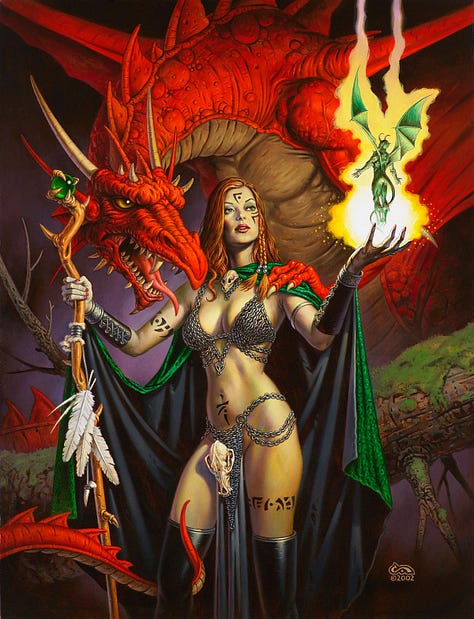


CC: I just recently learned about "Late Night Clyde Caldwell" and thought that to be a hoot. 'Elsbeth the Enchantress' was a personal painting I did back in 2002. The personal paintings are rare. It took me about 10 years to find the time to do another personal painting. 'Elsbeth...' was a fun painting to do.
I was working with model Christine Klingbiel at the time. In addition to modelling for me, she would work GenCons with me as well. I designed a chainmail costume for her to wear at the convention. The actual chain mail costume was produced by a fellow named Tim Calhoun, from my original design. People kept saying that I should do a painting of Christine in the costume, so I did, and produced a limited edition print of it.
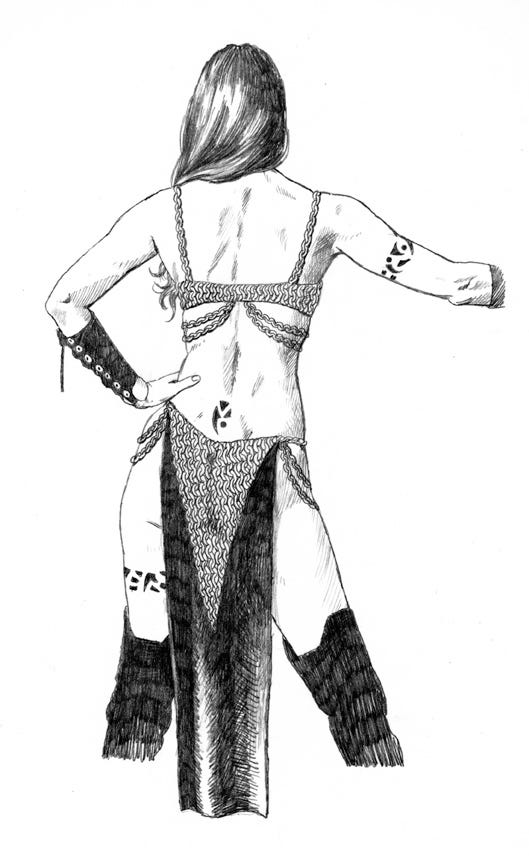
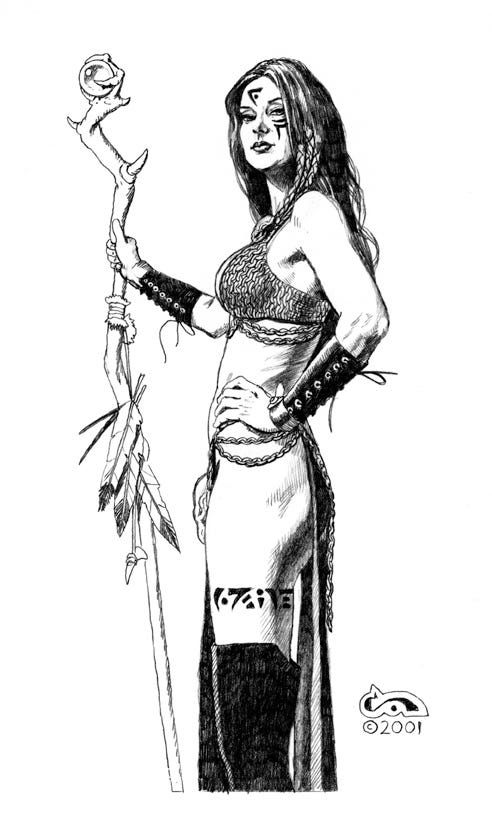
'Cally's War' is my favorite of the Science Fiction paintings I've done. I like it just because I thought it turned out really well. Christine was the model for that one too. I picked up the vinyl jumpsuit online, but Christine provided the shades, which I thought was a nice touch.
'Honor's Paradox' is another painting that I thought turned out nicely. I like the lion critter in it, and I liked the way the background turned out.
Plus, after you've done hundreds of paintings of a character facing off against a monster of some sort, it's really difficult to come up with poses that show the character's face. So, I thought 'Honor's Paradox' worked really well in that respect.
Christine posed for this one also. It was part of a series of book covers utilizing the same character, so I had the tunic made at a costume shop in Milwaukee, where I used to rent a lot of costumes.
@YoDanno is THE Biggest Clyde Caldwell fan I know, and a great guy to boot. For cool old school fantasy fun, make sure to follow him on Twitter. Here’s a couple of his Caldwell sweet tweets:


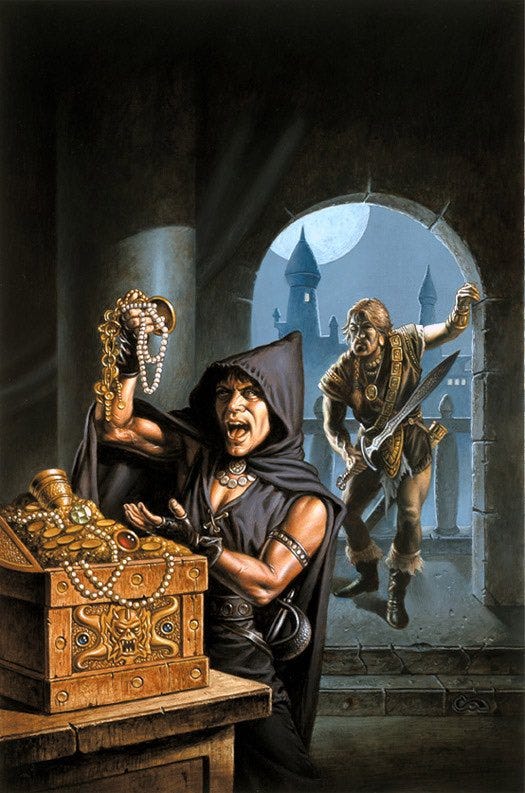



JQ: That’s so interesting, Clyde! Now, since we’re on this topic, a lot of your artwork features beautiful women that may not be in the fullest of attire. They’re based on live models you have commissioned over the years, but I just have to ask: How are you still married?
Let me put it this way: if my wife walked into the studio and I was drawing an in-person scantily clad lady, she’d be like, “Oh, so you like women with spears do you? Well I’ve got a spear for you right here.”
CC: First off, I could never afford to have a model standing around in my studio while I do the painting. They get paid by the hour, and pretty handsomely. So, I hire a model for a couple of hours to do a photo shoot, and work from the photos.
My wife, Sharon, and I are coming up on our 24th wedding anniversary this year. It's the second marriage for us both. When we met, I had already left TSR and was freelancing, so Sharon knew what I did for a living and had no objections. We dated for three years before tying the knot, so she knew that I worked with models, and I don't think she ever had a problem with it.
I always was professional and respectful with the female models, and I think Sharon knew that she could trust me not to do anything inappropriate. She has a lot of self-confidence, so I don't think she was ever threatened at all.
JQ: That makes sense, and congratulations to you and Sharon on your upcoming 24th anniversary!
For the last part of this interview, I’d like to switch gears a bit with some miscellany. I read somewhere that you like to play the guitar – Do you still play, and if so, what kind of music do you like to play?
CC: I haven't played the guitar in many years. I took up the guitar when I was 16, just before The Beatles hit in the US. My friend, Gary Mauney, started playing at the same time. I played guitar and he played bass. We sang together and soon started a garage band, playing a lot of British Invasion stuff, plus we wrote some of our own original material.
I only played in a couple of bands, then my daughter was born, so I had to get a job and support the family, and my music kind of fell by the wayside. Doing artwork, I just didn't have time to devote to it. I was at best a mediocre guitarist and, as a singer, my voice didn't have much range.
If I had stuck with it, I always thought I might have made a pretty good songwriter, but we'll never know.
One interesting story is that in my first band, we had a small fan following. One female fan had an uncle who worked for Mercury Records. She sent him some of our demo tapes and he wanted to give us a recording contract. Unfortunately, the band had broken up and the other guys had joined another band. None of us wanted to get back together to get the contract, so it never came to be.
One of my regrets in life is that I never kept up with playing the guitar. I always loved music and playing in the bands was some of the most fun I ever had.
JQ: I find it comforting to know that somewhere in a parallel universe, there’s a Clyde Caldwell Rockstar writing music, playing the guitar and singing his heart out. (I play ukulele by the way, so let me know if you ever want to get a jam session together.)
CC: I think my jammin' days are over.
JQ: Darn. Switching back to your art: I was always curious about your distinctive artist’s monogram. I can see the “C”, but what do the other stylistic elements signify? How did that come about and when did you design it?
CC: I was in North Carolina freelancing in the late 1970s, early 1980s. I was doing mostly advertising illustration, but was also doing some fanzine work too. I signed my ad work with my last name, and up until that point, had also signed my fanzine work with my last name as well.
I was a big fan of Jeff Jones and sometimes he would sign his work with just a J, with a dot (or period) surrounded by a box. I thought this was cool.
One day I was sitting at my drawing board doodling. I drew a C, then put a period after it. I added a little flourish, or a tail, to the C, which went over the top of the period. (This looked kind of like a stylized simitar to me.)
I then drew a line around the whole thing. This only took a couple of seconds, but when it was done, I kind of liked it, and decided to start signing my fanzine work with the symbol. I thought this would separate my advertising work from my fanzine work.
When I started doing professional SF/Fantasy work, I kept the symbol. I had an agent in NYC for awhile, and he wanted me to ditch the symbol and sign my work with my last name, but I resisted.
He thought no one would know who I was, without me actually signing my name to the work. I told him that if someone wanted to know who did a cover, they would check out the credits page in the book, make the name connection with the symbol, and would be more likely to remember it. My Dad always thought that the symbol looked like a fish.
And that's how my signature symbol came to be.
JQ: Epic! You definitely made the right call. Fans instantly recognize your cool-as-heck signature.
JQ: When I recently came across your online store, I also found your Facebook account, but it’s no longer maintained. How come? (If you can talk about it, since we don’t want the FB gods coming after us!)
CC: There's a story there, but I'll pass on answering this one.
JQ: Fair enough. On that Facebook page, I saw you used to post old Christmas ornament illustrations you made before your Fantasy Fame. Some of them even featured your daughter, who was a toddler at the time, Bleu! I think this is so neat. There’s something inspirational and beyond nostalgic to see evidence of your career progression along with integration with your family.
CC: Back when I was freelancing in NC, I was doing a lot of advertising art, graphic design and that sort of thing, in addition to doing some book cover art, etc. One reason that I took the job at TSR was so that I could do fantasy art full time.
For several years, I did quite a bit of work for a company in my hometown of Gastonia, NC, called Pyramid Industries. They produced Christmas ornaments. So, I did a lot of Christmas ornament artwork for them. I enjoyed doing the Christmas art, so it was fun. The weird thing about it was that I was doing it in the summer!
My daughter, Kelly (a.k.a. Bleu), posed a lot for me when she was little. Not only did she pose for some of the Christmas ornament art, but she posed for kids in some of my TSR Endless Quest covers. And she was my go-to model for halflings.
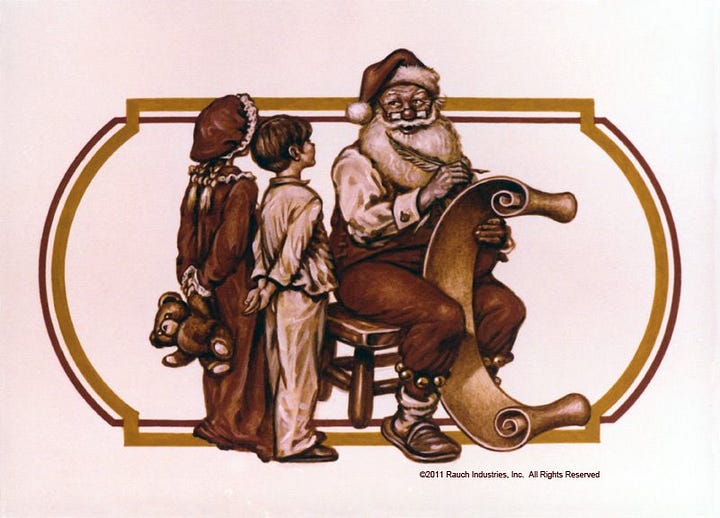
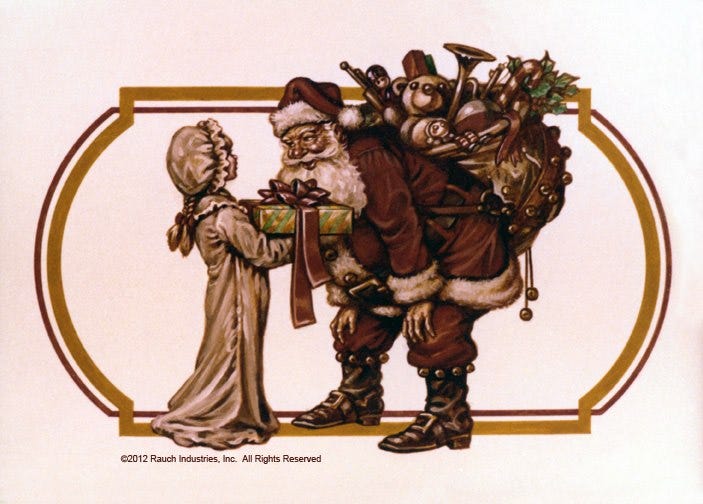
JQ: If there was one other thing you would have LOVED to have done for your career instead of being an artist, what would it be and why?
CC: We've already established that I love music, so that would have been one avenue, though as I said, I don't really think I had the talent for that.
No matter what, I would have done something creative. Whether it be art, music, writing, whatever...it would have been something creative.
JQ: Along those same lines, what advice would you give to kids today (or kids-at-heart like me) about following their dreams, their calling?
CC: I'd say, "Go for it." When I was young and living in NC, I remember looking at a Frank Frazetta cover on one of the Edgar Rice Burroughs books, and thinking how great it would be to be able to produce artwork like that for a living.
At the time, I never thought I'd be able to do it, since I figured you had to live in New York City to do that kind of work. I was just a small-town kid who couldn't imagine a scenario where that might happen.
I plugged away for years, amassing a lot of rejection notices, but kept trying to improve my artwork to the point where I would be able to break into the field. I didn't give up and it paid off. Persistence is key. And never let anyone tell you you're not good enough.
JQ: Incredible advice . . . and motivation. What do you hope the legacy of Clyde Caldwell will be?
CC: I always tried to do the best work I could do, given the limitations and parameters of any given project.
I always tried to give it 100%. So, I guess I'll just be happy if people remember my work fondly.
You can put on my tombstone, "Here lies Clyde Caldwell, one Hell of a Fantasy Artist."
JQ: There will be no doubt about people fondly remembering your work throughout all time. You and your fellow fantasy artists are the reason millions all over the world were drawn to fantasy books, magazines, and games in the first place. You gave form to our imaginations and inspiration to our souls.
I can’t thank you enough for making the time to do this virtual interview with me, Clyde. You are an amazing artist and human being as well.
If you ever come out to Colorado, give me a shout. I’d love to buy you a beer - and if you can’t make it - maybe I can come visit your studio the next time you have a model on hire (with my wife’s spear sticking out of my side, of course).
Clyde Caldwell runs his own online shop at www.clydecaldwell.com where you can see his work and buy the most incredible paintings, drawings, prints, posters, books and more. I absolutely love the prints I have of his - the colors, texture and scale are amazing (pictures don’t do them justice!)
(Featuring artwork from Clyde Caldwell & Luke Eidenschink!)






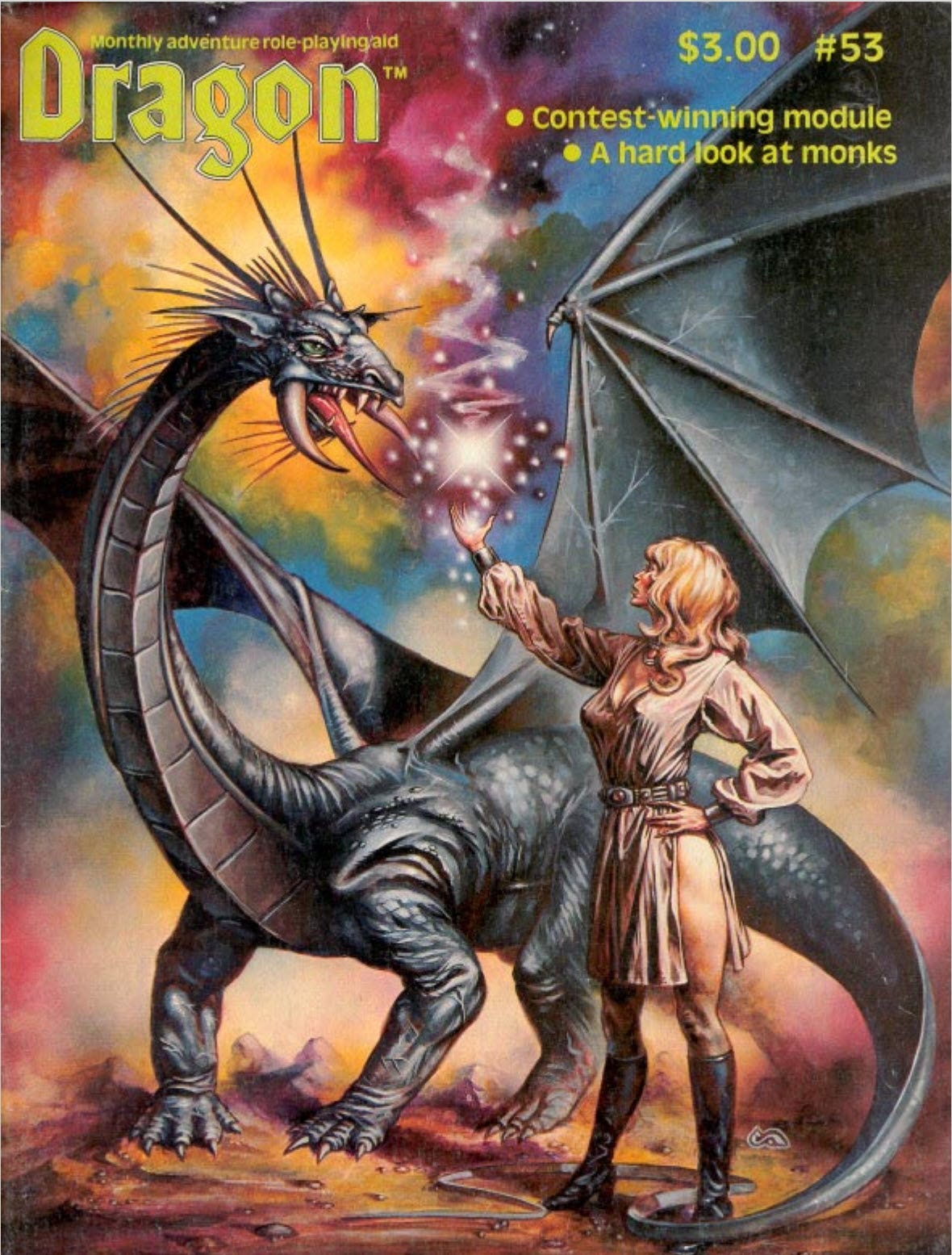
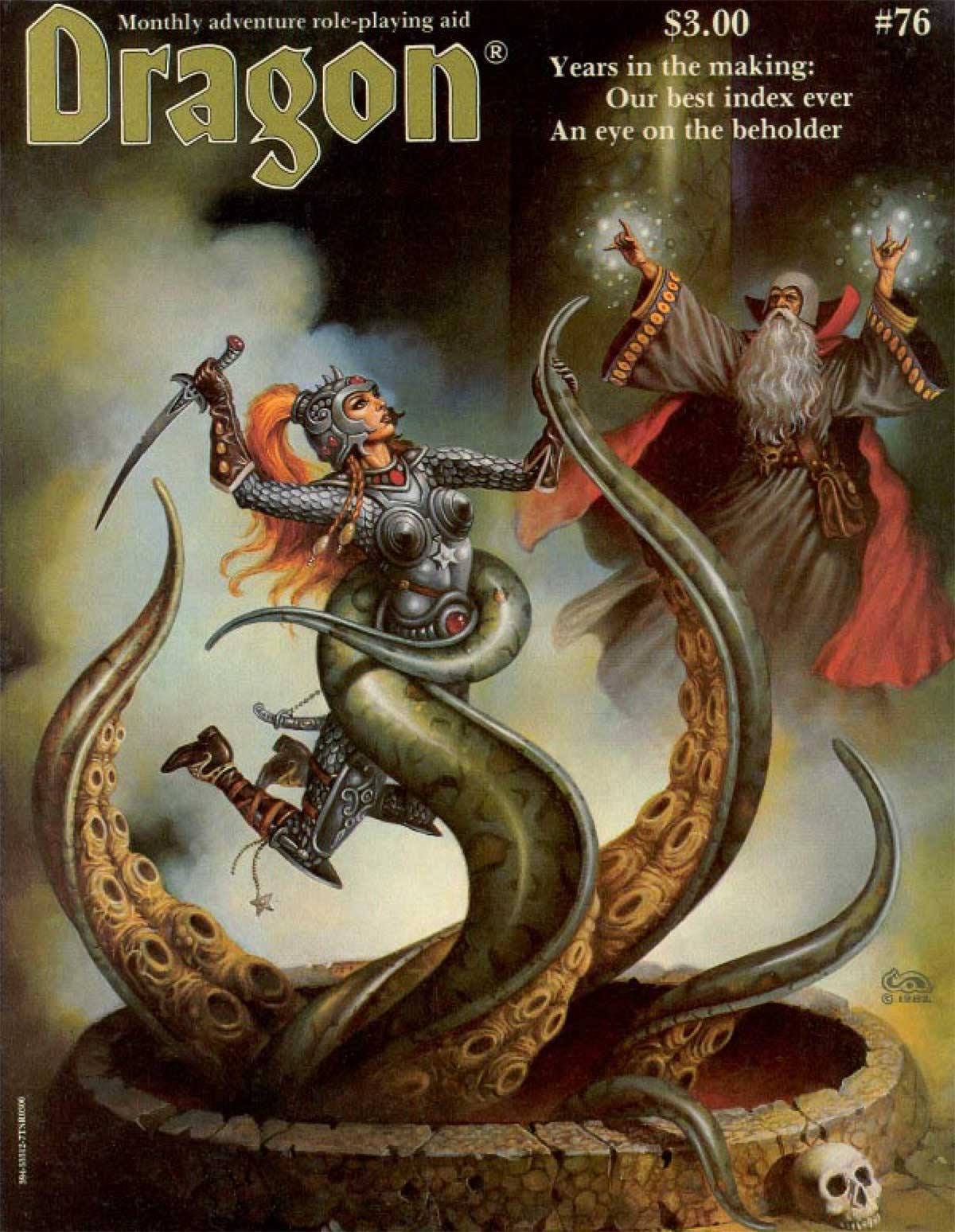




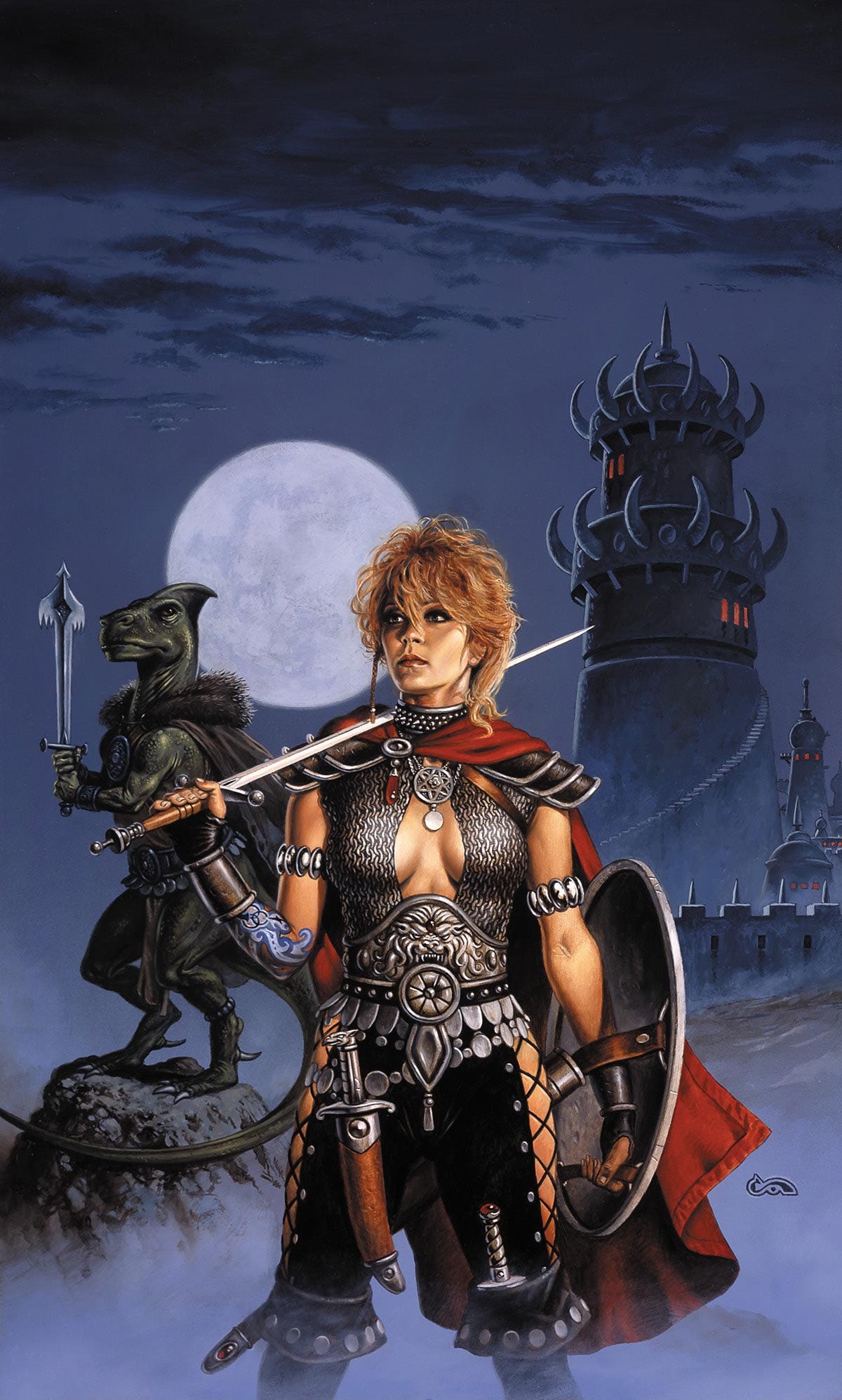



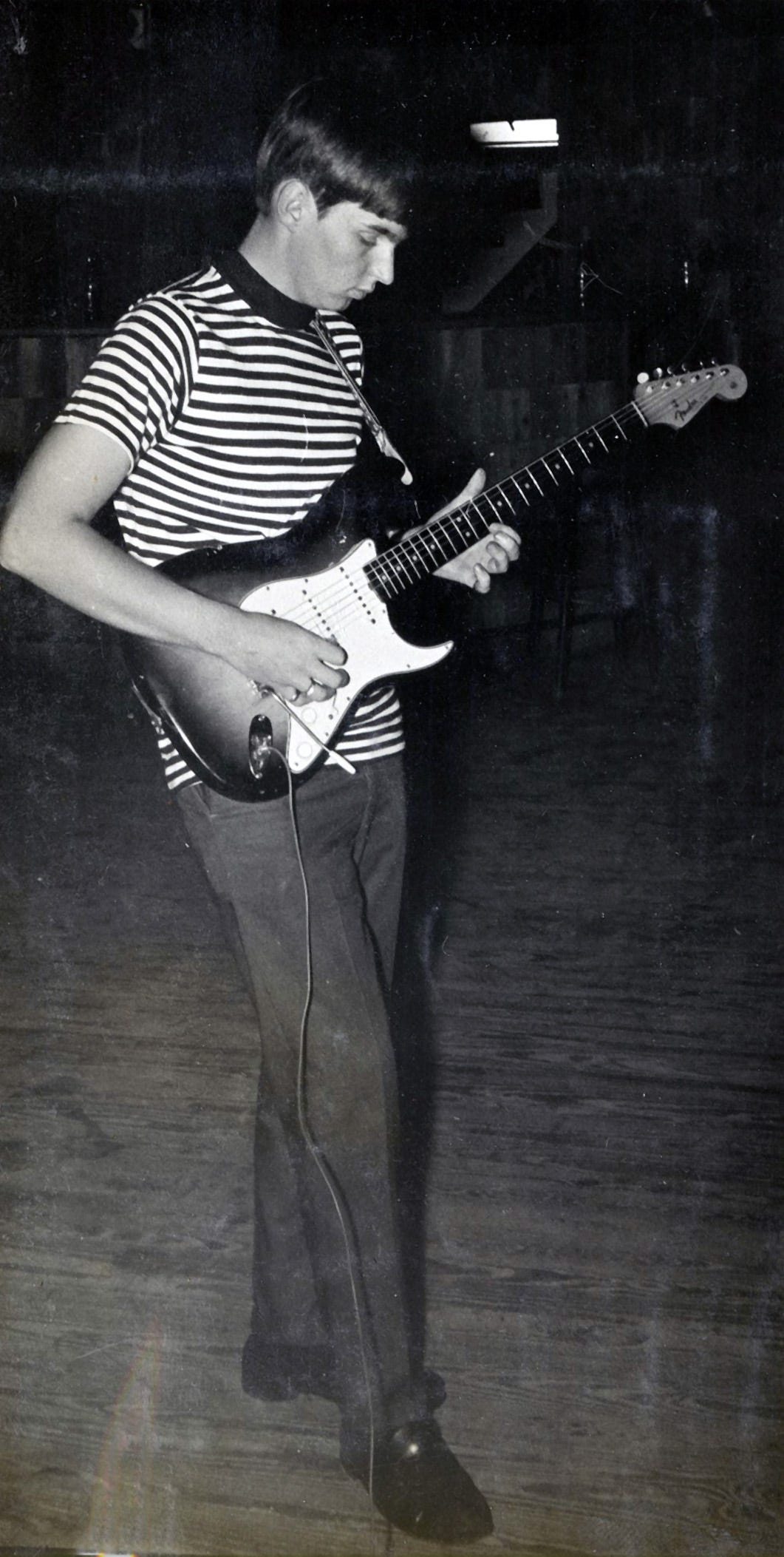





Great interview. I'm glad you got the story behind his signature symbol.
It's really amazing when tyou think about the artiistic talent at TSR in the 70s and 80s. I don't know if you have seen rect dnd art (basically from 90s onward) but it makes me lose my lunch.
Great interview! This was really entertaining.